Nearly nine months after ancient brain matter-turned-glass from a victim of the Vesuvius explosion was discovered, researchers have identified the victim's preserved brain cells and spinal cord remains.
The research, published in PLOS One, notes that the structure of the brain cells can be seen in the black, glassy material found in the young man's skull. In January, the glassy material was identified as vitrified brain remains.
Vitrification is the process by which "tissue ... has been burned at high heat and turned into glass or a glaze," according to the New England Journal of Medicine. Although rare to find, cerebral tissues found in archaeological discoveries have saponified, the process by which triglycerides turn into glycerol and fatty acid salts, or soap.

The temperature at the Collegium may have reached a maximum of 968 degrees Fahrenheit (520 degrees Celsius), based on charred wood that was found at the site. (Pier Paolo Petrone)
POMPEII SHOCKER: VITRIFIED BRAINS FROM VOLCANO VICTIM DISCOVERED
"The discovery of brain tissue in ancient human remains is an unusual event, but what is extremely rare is the integral preservation of neuronal structures of a 2000 years ago central nervous system, in our case at an unprecedented resolution," explained the study's lead author and forensic anthropologist at University Federico II of Naples, Pier Paolo Petrone, in a statement obtained by Fox News.
The researchers used scanning electron microscopy and advanced imaging tools to see the ancient neuron structures and come up with their findings.
“The results of our study show that the vitrification process occurred at Herculaneum, unique of its kind, has 'frozen' the neuronal structures of this victim, preserving them intact until today," Petrone added.
The remains of the 20-something-year-old man were discovered near the ancient town of Herculaneum, which was at the bottom of Mount Vesuvius when it erupted in 79 A.D.
In October 2018, a scrawled piece of text on a wall was discovered that suggested the eruption occurred in October of 79 A.D., two months later than previously thought.
The Roman city of Pompeii was devastated following the eruption of Mount Vesuvius in 79 A.D. Pompeii was quickly buried by volcanic ash, killing about 2,000 of the city’s residents, according to History.com.

A victim who perished in Pompeii after Mount Vesuvius erupted in A.D. 79. (Shutterstock)
Since their discovery in the 16th century, the Pompeii ruins have given researchers great insight into what life was like before Mount Vesuvius erupted and wiped out the entire city in 79 A.D. Recently, there has been some dispute about whether the volcano erupted in August or October of that year.
In April 2019, an ancient eatery known as a thermopolium (akin to a modern-day snack bar), where patrons could get drinks and hot food, was discovered among the city's ruins. Researchers have also found a fresco depicting a sensual scene involving the Roman god Jupiter and Leda and the remains of a petrified horse recently.
A "sorcerer's treasure trove" of items, including bones, skull charms and gems used for rituals, was also recently discovered.
DRAMATIC VOLCANO DEATH: HUGE FLYING STONE CRUSHED MAN IN POMPEII, ARCHAEOLOGISTS DISCOVER
When Mount Vesuvius erupted, the explosion caused such extreme heat that victims' skulls exploded, their blood boiled and their muscles, flesh and brains were replaced with ash, according to a study published in 2018.
CLICK HERE TO GET THE FOX NEWS APP
Fox News' James Rogers contributed to this story.

